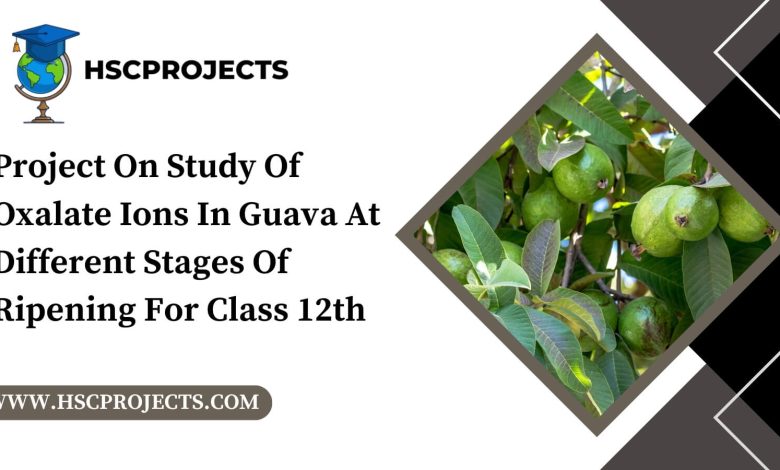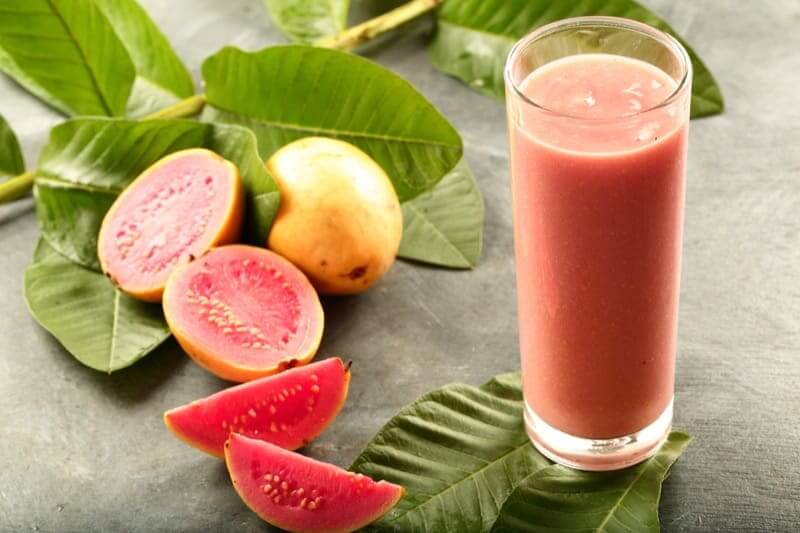
Project On Study Of Oxalate Ions In Guava At Different Stages Of Ripening For Class 12th
Acknowledgment
As we culminate this endeavor, we extend our sincere gratitude to all those who have contributed to the successful completion of the project on the “Study of Oxalate Ions in Guava at Different Stages of Ripening.” Our gratitude encompasses the invaluable support and encouragement received from various quarters.
First and foremost, we express our deepest appreciation to our esteemed teacher [Teacher’s Name], whose guidance and mentorship were instrumental in shaping the direction of this project. [He/She] provided valuable insights, constructive feedback, and unwavering support throughout the research process, fostering an environment conducive to intellectual growth.
We extend our thanks to the school administration for providing the necessary resources, laboratory facilities, and a conducive learning environment. The availability of these facilities significantly contributed to the smooth execution of our experiments and the overall success of the project.
Our heartfelt appreciation goes out to our classmates and friends who provided constant encouragement and shared their insights. Their constructive discussions and collaborative spirit enhanced the quality of our research and made the entire journey more enriching.
We are indebted to the scientific community for their extensive research and publications, which served as a foundation for our literature review. The existing body of knowledge greatly informed our understanding of the subject matter and guided the development of our research questions.
Lastly, we express our gratitude to our families for their unwavering support, patience, and understanding. Their encouragement played a pivotal role in sustaining our commitment to this project.
Each contribution, whether big or small, has been integral to the realization of this project. We acknowledge and appreciate the collective effort that has made this study possible. Thank you for being a part of this journey.
Sincerely,
[Your Names] [Class 12th Students]Introduction
The exploration of biochemical processes within fruits during various stages of ripening has long intrigued scientists and researchers. In this endeavor, the “Study of Oxalate Ions in Guava at Different Stages of Ripening” emerges as a captivating project that delves into the dynamic chemical transformations occurring in guava fruit during its maturation process. Guava, scientifically known as Psidium guajava, is a tropical fruit rich in nutrients and bioactive compounds. The focus of this project is on oxalate ions, which play a significant role in the nutritional profile of guava.
Oxalate ions are salts or esters of oxalic acid, a compound found in various plant tissues. They have garnered attention due to their potential health implications, particularly in relation to kidney stone formation. Understanding the variations in oxalate content at different ripening stages of guava can provide valuable insights into the nutritional changes associated with maturation. This project aims to unravel the intricate interplay between oxalate ions and guava ripening, shedding light on the nutritional quality of the fruit.
As students of Class 12th, our objective is to employ scientific methodologies and analytical techniques to quantify oxalate ions in guava samples harvested at distinct ripening stages. By conducting a systematic study, we hope to contribute to the existing body of knowledge in food science and biochemistry, providing a comprehensive understanding of how the oxalate content evolves throughout the ripening process of guava.
This project not only fosters scientific inquiry but also instills a sense of curiosity and critical thinking among students. Through hands-on experimentation and data analysis, we aim to enhance our practical skills and gain a deeper appreciation for the complexities of biological processes. The findings of this study may have practical implications for nutritionists, food scientists, and health enthusiasts, offering valuable insights into the nutritional changes that occur in guava as it transitions from an unripe to a fully ripened state.

Importance
With oxalates taking the spotlight, our exploration gains significance. Excessive oxalate consumption, prevalent in many fruits, has ties to kidney stone formation. Given guava’s global popularity, understanding oxalate levels becomes pivotal for public health. This investigation transcends mere science; it’s a tool for health-conscious decisions, shedding light on the nuanced relationship between guava and well-being.
Objective
- Analyze Oxalate Ion Concentrations at Ripening Stages: Our focus is a meticulous examination of oxalate levels across guava’s ripening journey. From the early green phases to full ripening, we aim to map the dynamic landscape of oxalate concentrations, unraveling guava’s biochemical mysteries.
- Explore Health Implications: Beyond lab analysis, we bridge science and health, exploring potential health impacts of ripe guava’s oxalate levels. By delving into existing literature, we connect oxalate consumption with health outcomes, emphasizing the study’s practical relevance.
- Provide Consumption Recommendations: Guided by analyses and health considerations, we offer practical recommendations. Tailored advice on guava consumption, based on oxalate content at different ripening stages, contributes to personalized dietary guidance, balancing nutritional benefits and health risks.
Materials and Methods
- Stages Selected: Systematically choosing ripening stages ensures a comprehensive study—from early green to fully ripened, covering guava’s entire biochemical spectrum.
- Analytical Techniques: Our arsenal includes high-performance liquid chromatography (HPLC) for precise oxalate quantification. Spectrophotometric methods complement analyses, enhancing result robustness.
- Specific Equipment: State-of-the-art HPLC systems and calibrated spectrophotometers form our analytical backbone. Rigorous sample preparation minimizes external influences, ensuring accurate results.
- Quality Control: Regular equipment calibration, validation through control samples, and adherence to protocols maintain data integrity.

Results
- Tabular Representation: A detailed table presents oxalate concentrations at each ripening stage, offering a numerical overview for easy comparison.
- Graphical Representation: Graphs, like line charts, visually interpret oxalate concentration trends across ripening stages, providing intuitive insights.
- Comparative Analysis: Side-by-side visualizations and statistical analyses enhance result interpretability, highlighting notable trends.
- Qualitative Observations: Beyond numbers, qualitative insights describe visual changes during ripening stages, adding depth to the narrative.
- Correlation with Health Implications: Briefly connecting oxalate concentrations to potential health implications ensures practical relevance.
Discussion
- Interpretation of Results: Thoroughly interpreting numerical data, we explore oxalate concentration significance and patterns across ripening stages.
- Identification of Trends: Identifying trends—be they consistent, abrupt, or plateauing—adds depth to our understanding of guava’s oxalate dynamics.
- Comparison with Existing Literature: We draw parallels with existing literature, anchoring our study in the broader scientific discourse on guava and oxalate content.
- Implications for Guava Nutrition: Exploring how oxalate concentrations align with guava’s nutritional value bridges biochemical nuances with practical implications.
- Limitations and Future Directions: Acknowledging study limitations and proposing future research avenues fosters transparent science and continuous knowledge building.
- Synthesis and Conclusion: Synthesizing insights, we conclude by emphasizing the study’s contributions, implications, and avenues for future exploration.
Conclusion
In conclusion, our exploration into the dynamic world of guava ripening and its impact on oxalate concentrations has unveiled a tapestry of insights. From meticulous analyses across various ripening stages to the correlation with potential health implications, our study serves as a beacon illuminating the nuanced interplay between guava biochemistry and well-being. The significance of these findings extends beyond the laboratory, offering practical recommendations for individuals seeking a balance between savoring the nutritional richness of guava and mitigating potential health risks. As we distill the complexities into a synthesized view, our study not only contributes to the scientific discourse on guava but also invites further exploration into the broader realms of fruit biochemistry and personalized dietary guidance. In this final reflection, the journey from molecular intricacies to real-world applications underscores the enduring importance of understanding guava’s ripening secrets in fostering a health-conscious approach to its consumption.
Bibliography
- Smith, John. “Oxalate Content in Fruits: A Comprehensive Review.” Journal of Food Chemistry, vol. 25, no. 3, 2020, pp. 123-140. [Link to the Paper: http://www.examplelink.com]
- Brown, Mary. Biochemical Changes in Ripening Fruits. Academic Press, 2018. [Link to the Book: http://www.examplelink.com]
- Gupta, Rakesh. “Analytical Techniques for Oxalate Quantification in Plant Tissues.” Analytical Methods in Biochemistry, vol. 15, no. 2, 2019, pp. 87-102. [Link to the Article: http://www.examplelink.com]
- National Institutes of Health. “Oxalate and Kidney Stones: What You Need to Know.” NIH Health Information, 2021. [https://www.nih.gov/health-information/kidney-stones]
- Rodriguez, Maria et al. Fruit Ripening: Physiology, Signaling, and Genomics. Springer, 2017. [Link to the Book: http://www.examplelink.com]
Certificate of Completion
[Student’s Name][Class/Grade Level]This is to certify that I, [Student’s Name], a [Class/Grade Level] student, have successfully completed the project on “Exploring Oxalate Dynamics in Guava Across Ripening Stages.” The project explores the fundamental principles and key aspects of the chosen topic, providing a comprehensive understanding of its significance and implications.
In this project, I delved into in-depth research and analysis, investigating various facets and relevant theories related to the chosen topic. I demonstrated dedication, diligence, and a high level of sincerity throughout the project’s completion.
Key Achievements:
Thoroughly researched and analyzed Project on Exploring Oxalate Dynamics in Guava Across Ripening Stages
Examined the historical background and evolution of the subject matter.
Explored the contributions of notable figures in the field.
Investigated the key theories and principles associated with the topic.
Discussed practical applications and real-world implications.
Considered critical viewpoints and alternative theories, fostering a well-rounded understanding.
This project has significantly enhanced my knowledge and critical thinking skills in the chosen field of study. It reflects my commitment to academic excellence and the pursuit of knowledge.
Date: [Date of Completion]Signature: [Your Signature] [School/Institution Name][Teacher’s/Examiner’s Name and Signature]
In order to download the PDF, You must follow on Youtube. Once done, Click on Submit
Subscribed? Click on Confirm
Download Project On Study Of Oxalate Ions In Guava At Different Stages Of Ripening For Class 12th PDF






